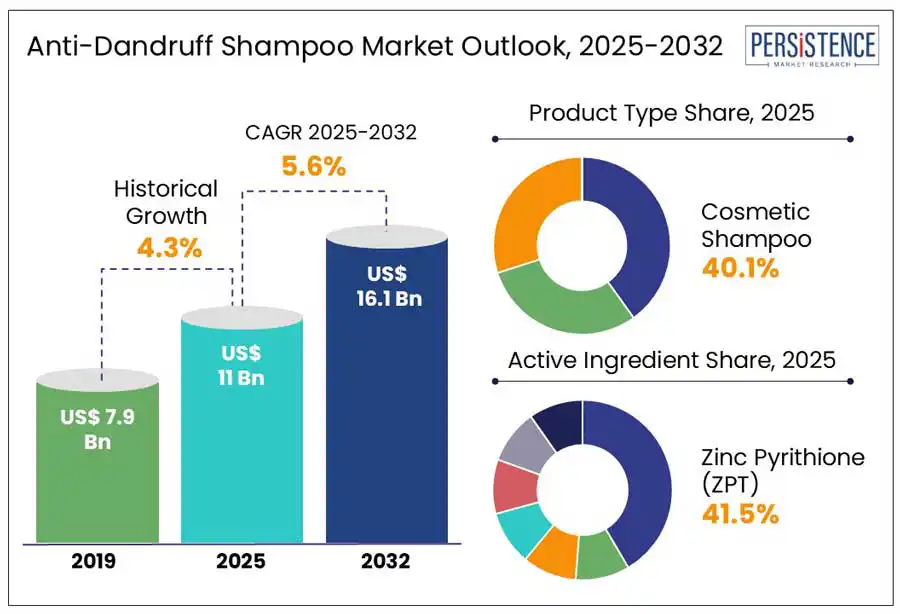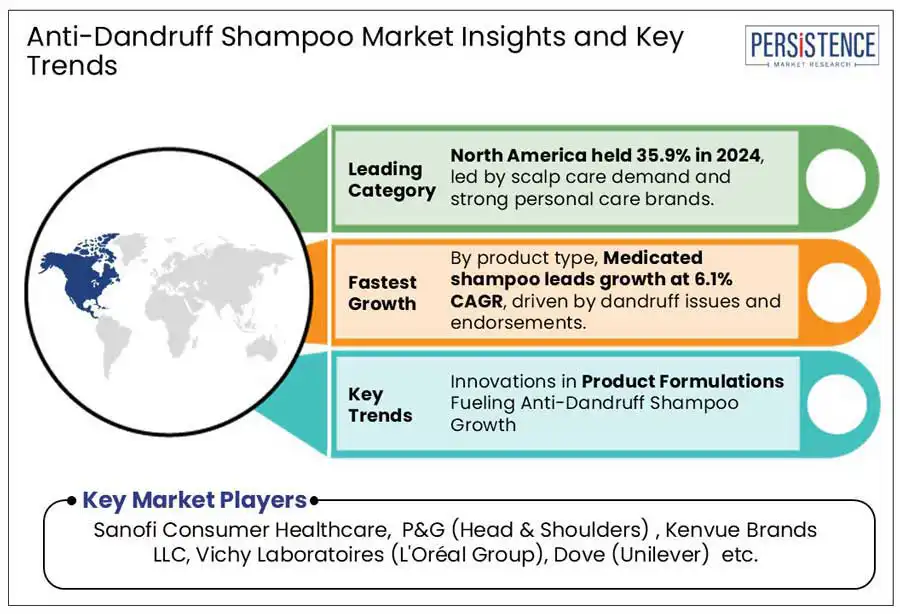Industry: Consumer Goods
Published Date: April-2025
Format: PPT*, PDF, EXCEL
Delivery Timelines: Contact Sales
Number of Pages: 160
Report ID: PMRREP35213
The global anti-dandruff shampoo market is anticipated to reach a value of US$11.0 billion in 2025 and witness a CAGR of 5.6% from 2025 to 2032. The industry is poised to attain a value of US$16.1 billion during the forecast period. According to the Persistence Market Research report, the global rise in dandruff-related scalp issues is expected to drive substantial growth. Increasing consumer awareness, proactive government and healthcare campaigns promoting scalp health, and advancements in dermatological formulations are fueling market expansion.
Consumers are now looking for products that meet their specific scalp needs. For instance, in 2023, a new study conducted by dermatologists indicated that a new type of anti-dandruff shampoo using a mix of ketoconazole and zinc oxide nanoparticles made with green tea extract worked better against Malassezia furfur, the fungus that causes dandruff, compared to regular treatments. Thus, the anti-dandruff shampoo market is shifting toward products that are scientifically proven, made with natural ingredients and deliver effective results.
Consumers choose shampoos that treat dandruff and support overall scalp health. This growing demand is driven by greater awareness, rising concerns about hair and scalp conditions, and improved access to advanced hair care solutions.

Key Industry Highlights:
|
Global Market Attribute |
Key Insights |
|
Anti-Dandruff Shampoo Market Size (2025E) |
US$ 11.0 Bn |
|
Market Value Forecast (2032F) |
US$ 16.2 Bn |
|
Projected Growth (CAGR 2025 to 2032) |
5.6% |
|
Historical Market Growth (CAGR 2019 to 2024) |
4.3% |
Consumers are increasingly recognizing that dandruff is not just a cosmetic concern but often a symptom of underlying scalp issues, such as fungal infections, excess oil production, or dryness. This shift in perception has driven a growing demand for shampoos that offer therapeutic benefits, addressing the root causes of dandruff rather than just removing flakes. As online dermatology content and awareness by brands is highly offered, consumers are becoming more informed about the importance of scalp health in overall well-being. In response, brands are launching innovative products with clinically proven ingredients such as Zinc Pyrithione, ketoconazole, salicylic acid, and tea tree oil. For instance, in 2025, CeraVe introduced its ‘Head of CeraVe’ campaign to spotlight its new Hydrating Anti-Dandruff Shampoo and Conditioner, aiming to normalize dandruff care while promoting inclusive, accessible self-care for all.
High treatment costs and potential side effects remain key restraints in the market. Premium formulations, especially those containing medicated or dermatologically tested ingredients, are often priced higher, limiting accessibility for price-sensitive consumers. Additionally, certain chemical agents such as ketoconazole or selenium sulfide may cause irritation, dryness, or allergic reactions, deterring consistent use. These concerns contribute to consumer hesitation, particularly in regions with limited dermatological awareness. Without proper guidance or visible results, users may discontinue treatment altogether, impacting long-term market growth and brand loyalty across both emerging and developed economies.
The global anti-dandruff shampoo market. Brands are increasingly offering tailored formulations targeting specific scalp types, hair textures, and concerns, including herbal, medicated, and sulfate-free options. This diversification caters to evolving consumer preferences and boosts brand loyalty. Simultaneously, the rapid rise of e-commerce platforms enables broader product reach, personalized marketing, and direct consumer engagement. Online reviews and influencer partnerships further enhance visibility and trust. As digital channels continue to reshape consumer buying behavior, companies leveraging both diversified product lines and robust online strategies are well-positioned to capitalize on emerging market opportunities.
Cosmetic shampoos are projected to lead the global market, capturing a 40.1% share in 2025. Their widespread popularity is driven by the ease of availability, appealing fragrance, and dual functionality, offering both dandruff control and cosmetic benefits such as smoothness, shine, and fragrance. These shampoos are widely adopted for regular use, especially among consumers seeking mild formulations for daily scalp wash.
A growing preference for over-the-counter solutions with natural or herbal ingredients has further fueled segment growth. In contrast, medicated shampoos serve more targeted needs but remain secondary in terms of overall consumer adoption, largely due to their strong formulations, potential side effects, and limited suitability for long-term or daily use, which often deters broader market appeal.
Zinc Pyrithione (ZPT) is projected to dominate with 41.5% share in 2025. Widely recognized for its strong antifungal and antibacterial properties, ZPT effectively combats Malassezia, the primary fungus linked to dandruff. Its ability to reduce scalp flaking, itching, and irritation makes it a preferred active ingredient in daily-use shampoos. ZPT’s compatibility with both cosmetic and medicated formulations further enhance its market appeal. Backed by clinical efficacy and broad consumer acceptance, the growing use of ZPT continues to drive product innovation and segment growth across global markets.
Alongside Zinc Pyrithione, salicylic acid is gaining traction due to its keratolytic properties, which helps exfoliate dead skin cells and reduce scalp buildup, offering relief from flaking and irritation. Selenium Sulfide, known for its potent antifungal action, is also widely used in medicated shampoos to target severe dandruff and seborrheic dermatitis, reinforcing its relevance in therapeutic formulations.

?North America anti-dandruff shampoo market has witnessed a consistent growth, driven by high consumer awareness with focus on scalp health, and an increasing demand for dermatologist-approved formulas. The U.S. accounts for a large share, with over-the-counter (OTC) medicated shampoos regulated by the FDA, including active ingredients such as Zinc Pyrithione, salicylic acid, and ketoconazole. As more consumers prioritize safety and transparency, brands are launching sulfate-free, cruelty-free, and eco-friendly variants. E-commerce growth and pharmacy chains such as CVS and Walgreens have expanded market access. Additionally, public health campaigns supporting scalp wellness are helping destigmatize dandruff issues and promote proactive hair care solutions across North America.
?Europe's anti-dandruff shampoo market continues to grow steadily, driven by increasing consumer demand for mild, dermatologically tested, and environmentally responsible formulations. Germany dominates the region, with a strong inclination toward science-based solutions, while emerging markets such as the U.K. and France are gaining momentum due to rising improved retail access.
Additionally, regulatory support and initiatives promoting skin and scalp health in countries such as France and Germany further encourage product adoption. Brands such as Head & Shoulders and Nizoral continue to lead, while local and organic brands are capturing niche markets. Promotions centered around sensitive skin and sustainable packaging have boosted consumer engagement. Campaigns focusing on “clean beauty” and transparency, along with government-backed awareness programs for skin conditions such as psoriasis and seborrheic dermatitis are propelling anti-dandruff product demand throughout the region.
Asia Pacific is poised to witness a fast-growth driven by its large population, hot and humid climate, and increasing awareness of scalp health. India leads with a strong preference for herbal and medicated solutions using ingredients like neem, tulsi, and tea tree oil.
China is rapidly expanding due to the growing popularity of premium international brands. Government programs promoting hygiene and personal care such as India’s Swachh Bharat campaign, are contributing to better grooming habits. Himalaya and Dabur are gaining a high ground alongside global players such as Head & Shoulders and Selsun Blue. Influencer marketing, celebrity endorsements, and digital campaigns on platforms such as TikTok and Instagram are effective in accelerating brand presence and market penetration in the region.?
The anti-dandruff shampoo market is highly competitive, driven by innovation, product development, and strategic partnerships. Leading companies such as Unilever, Procter & Gamble, L'Oréal, and Johnson & Johnson focus on advanced formulations with ingredients such as zinc pyrithione and ketoconazole. Rising consumer demand for natural and organic products is encouraging new entrants with herbal and clean-label alternatives. Mergers, acquisitions, and collaborations help expand brand portfolios and global reach. Continuous R&D investments support the launch of more effective solutions, intensifying competition. As consumer awareness grows, brands are emphasizing scalp health, sustainability, and dermatologically tested products to strengthen market positioning.
|
Report Attribute |
Details |
|
Historical Data/Actuals |
2019 - 2024 |
|
Forecast Period |
2025 - 2032 |
|
Market Analysis Units |
Value: US$ Bn, Volume: As applicable |
|
Geographical Coverage |
|
|
Segmental Coverage |
|
|
Competitive Analysis |
|
|
Report Highlights |
|
|
Customization and Pricing |
Available upon request |
By Product Type
By Active Ingredient
By Consumer Group
By Form
By Distribution Channel
By Region
To know more about delivery timeline for this report Contact Sales

The global market is estimated to increase from US$ 11.0 billion in 2025 to US$ 16.2 billion in 2032.
The rising prevalence of seborrheic dermatitis, increased dermatological consultations, expanding retail channels, and product innovations with clinically proven ingredients drive market growth.
Emerging markets expansion, unmet needs in sensitive scalp care, male grooming trends, premium herbal formulations, and e-commerce penetration offer significant opportunities.
The market is projected to record a CAGR of 5.6% during the forecast period from 2025 to 2032.
Sanofi Consumer Healthcare, P&G (Head & Shoulders), Kenvue Brands LLC, Vichy Laboratoires (L'Oréal Group), and Dove (Unilever).